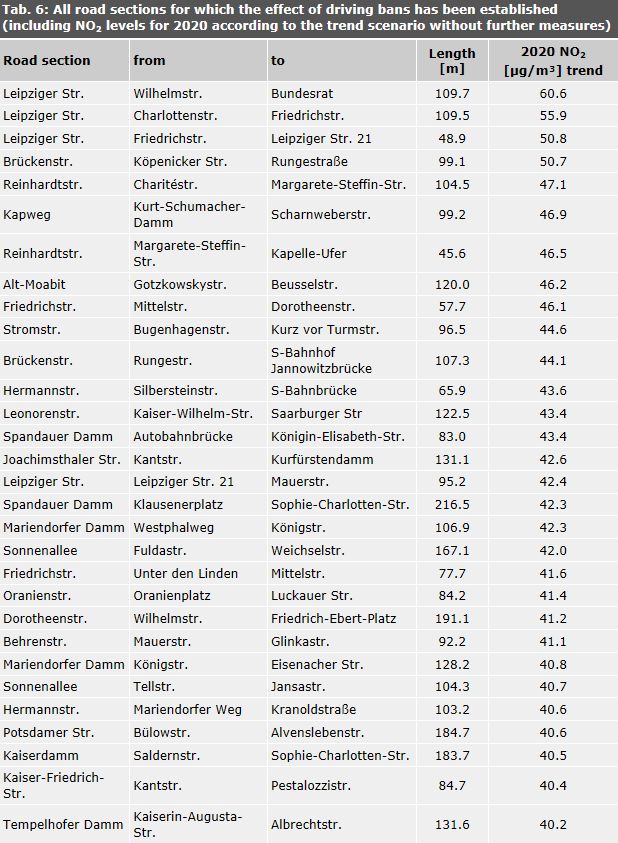Scenario calculations on the effect of selected measures
The effect measures have on emissions and immission were modelled based on the trend prognosis for the year 2020 without the influence of measures. Measures for road traffic were selected with the goal of reducing NO2 pollution along roads.
Measures expected to lower emission throughout the city or for the majority of road sections exceeding the limit were investigated. Additionally, appropriate models for calculating the effect had to be available. For some measures, multiple scenarios were developed. Based on these, the scope of the measures required to be able to comply with the limits was thus estimated as were strategies on how to avoid inappropriate burdens. Some of the measures were developed in detail, e.g. those for parking management, regardless of whether they are actually suitable for modelling. This serves to ascertain the possible potential for reduction, first of all.
When a measure is included in the scenarios or in the selected area of implementation, this does not mean that the measure will definitely be part of the Clean Air Plan. Deciding factors include effectiveness, proportionality, affordability and the technical, legal and administrative feasibility.
Scenario 7 "Vehicle technology": – Retrofits on diesel vehicles
Improvements in vehicle technology are suitable for reducing pollutant emissions in the entire vehicle fleet. Lower emissions can be achieved by replacing vehicles with high pollutant emissions with low-emission vehicles. These include electric or electric hybrid vehicles, vehicles powered by natural gas or diesel vehicles with low real NOx emissions. A further measure to lower emissions is to retrofit existing vehicles with additional exhaust gas treatment systems (hardware retrofitting).
The "Vehicle technology" scenario is based on assumptions regarding vehicle replacement and hardware retrofitting, which are summarised in Table 2. As scenarios were calculated in autumn 2018, the requirements for hardware retrofitting of passenger cars and light commercial vehicles set by the BMVI (Federal Ministry of Transport and Digital Infrastructure) could not yet be considered. The "Technical requirements for nitrogen oxide (NOx) reduction systems with increased reduction performance for retrofits on passenger cars and similar vehicles (NOx reduction systems for passenger cars)" published by the BMVI on December 28, 2018 could therefore not be taken into account. These requirements do not stipulate a specific degree of effectiveness, but an emission value of 270 mg/km based on the average of what is called an RDE test drive. This involves measuring exhaust emissions in real road traffic (real driving emissions). The emission model used here is based on the emission factors of the Handbook Emission Factors for Road Transport (HBEFA) recommended by the Federal Environment Agency. Such specifications cannot be used for the model directly, however, as the HBEFA differentiates emission specifications according to traffic situations.
Based on the results of retrofits on Berlin’s public buses, 70 % was assumed as the level of effectiveness for retrofits on passenger cars and light commercial vehicles. For heavy goods vehicles weighing more than 7.5 t, the level of effectiveness applied was 85 %, according to the BMVI funding guidelines regarding retrofits on heavy municipal vehicles. No retrofits or replacements were assumed for buses for 2020, as the retrofitting of BVG buses was already included in the 2020 trend prognosis.
The assumed proportions of retrofitted vehicles yield correction factors for the HBEFA emission factors ranging from 0.51 to 0.93. This represents emission reductions between 7 % and 49 % for each vehicle group. Replacing Euro 4 diesel cars with Euro 6d-TEMP vehicles influences the representative proportions of the fleet regarding the emission analysis.


![Table 3: Comparison of the annual emissions of the total motor vehicle traffic [t/a] and emissions by vehicle type for the 2020 trend prognosis and the technology](/imgscaler/c-z7yOq4MyA1JmUkvISL2l-skuwNx9wGwsS8y6oSEFQ/ropen/L3N5czExLXByb2QvdW13ZWx0YXRsYXMvX2Fzc2V0cy9sdWZ0L3N0cmFzc2VudmVya2Voci1lbWlzc2lvbmVuLXVuZC1pbW1pc3Npb25lbi9kcy1nL2VuLXRhYmVsbGVuL2V0ZzMxMV8wMy5naWY.jpg?ts=1681406605)




![Table 8: NO2 annual means [µg/m³] for the 2020 trend prognosis (routes with annual mean NO2 levels above 40 µg/m³) and driving ban scenarios 1-4](/imgscaler/eYTvydyK5a5PpnVl6rGRQFs8Hkc329Lkntz2bnCAcls/ropen/L3N5czExLXByb2QvdW13ZWx0YXRsYXMvX2Fzc2V0cy9sdWZ0L3N0cmFzc2VudmVya2Voci1lbWlzc2lvbmVuLXVuZC1pbW1pc3Npb25lbi9kcy1nL2VuLXRhYmVsbGVuL21heHNpemVfMmM3MjgzNjFmYTM0MWU1NThiMDZkYjBiM2MyZTg1NjlfZXRnMzExXzA4LmdpZg.jpg?ts=1681406603)
![Table 9: NO2 annual means [µg/m³] on road sections which show NO2 values above 40 µg/m³ for the first time, due to diverted traffic in scenarios 1-4](/imgscaler/qbjEsNekV8sxjLTtyHZEbpgytsjlaCgs-maSd_DlNgo/ropen/L3N5czExLXByb2QvdW13ZWx0YXRsYXMvX2Fzc2V0cy9sdWZ0L3N0cmFzc2VudmVya2Voci1lbWlzc2lvbmVuLXVuZC1pbW1pc3Npb25lbi9kcy1nL2VuLXRhYmVsbGVuL2V0ZzMxMV8wOS5naWY.jpg?ts=1681406607)